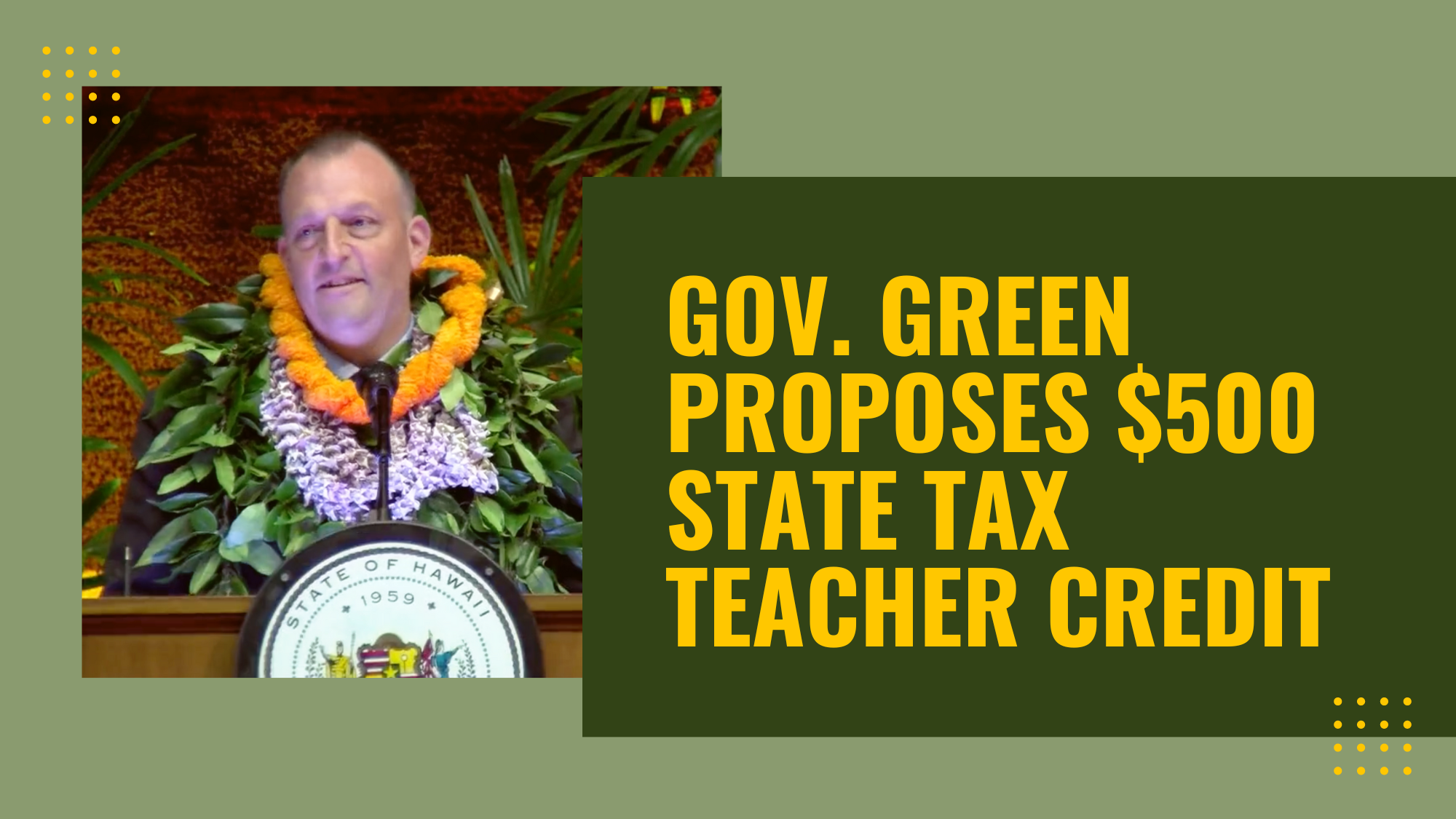HSTA members reported spending an average $953 out of pocket a year on supplies in recent survey
Posted: January 23, 2023
Gov. Josh Green Monday proposed a nonrefundable state tax credit of up to $500 per year for school supplies purchased by K–12 teachers, one of many proposals unveiled in his State of the State Address.
Speaking in the state House chambers, Green told lawmakers, “We’ve announced a new Educator Tax Credit so that our teachers can receive a $500 credit to support our students.”
In supplemental documentation to the Legislature, Green said the new teacher tax credit “would reduce the burden that teachers assume for providing essential classroom materials and conditions.”
The governor “acknowledges this burden of costs that teachers themselves incur to develop curricula, resources, and other items their students need to succeed,” the documentation said.
A Hawai‘i State Teachers Association survey answered by more than 530 educators across the islands this month found the survey respondents reported spending an average of $953 of their own money a year on various classroom supplies.
Educators who answered the survey said they spent anywhere from $75 to $4,000 annually out of their own funds on various classroom supplies, conferences and many other expenses.
An Oʻahu high school teacher reported spending hundreds in personal money every year on basics, because “sometimes parents are unable to provide classroom supplies, so pencils, paper, composition books, etc.”
An educator at a Hilo-area intermediate school listed annual personal spending of $1,000 on “typical classroom supplies: tablets, folders, binders, binder paper, construction paper, pencils, pens, tissue paper, paper towel, manila folders, sheet protectors. I also purchase snacks on a monthly basis and use it as a reward for my students. Chips, cookies, granola.”
An Oʻahu teacher reported spending between $1,000 to $1,500 a year on “subscriptions to educational apps and sites, art supplies, books for class library, school supplies for kids who cannot afford or parents don’t buy, cleaning supplies, science experiment supplies, field trip fees for children who cannot afford it, lei for speakers/visitors, parking fees for workshops, professional development, recess equipment, and snacks for hungry children who miss ‘free’ breakfast on campus because they are tardy, etc.”
A teacher on Maui reported spending $2,000 to $3,000 out of her own pocket each year on “books for classroom library, prizes for classroom store, decorations for classroom, student Christmas gifts, student end-of-the-year gifts, art supplies, classroom treats, teacher supplies, classroom supplies.”
A Kauaʻi teacher reported spending $3,000 a year on lab supplies, project supplies for class and science fairs, snacks for students, professional development and conferences, classroom/school supplies, and furniture.
Earlier this month, Green told HSTA, “I appreciate everything our teachers do for our keiki and realize that the current federal $300 teacher tax deduction doesn’t nearly cover what our teachers spend out of their own pockets for their classes.”
Green said creating a nonrefundable state tax credit for teachers worth $500 would “account for a portion of those out-of-pocket expenses.”
HSTA President Osa Tui, Jr. expressed gratitude for the governor’s proposal.
“Gov. Green has been a strong supporter of Hawaiʻi’s public school educators during his tenures as representative, senator, and as lieutenant governor. We look forward to his continued strong support as he begins his governorship and appreciate his recognition of how our educators go above and beyond to enhance the educational experiences for Hawaiʻi’s keiki,” Tui said.
In 2004, a $250 federal teacher tax deduction was created by Congress and the president as part of a tax reform package. Now called the Educator Expense Deduction, it was later increased to $300 a year.
Green’s cost of living bill offers other tax relief measures
The governor Monday also announced a large tax relief proposal called the Green Affordability Plan that would cut taxes if adopted in full by the Legislature and provide more than $300 million in tax relief annually for the people who need it most.
“This will help us get money into the pockets of working families so that they can purchase essential goods and services like food, medicine, and housing, which will in turn stimulate our economy,” Green said.
This plan provides universal tax relief by:
- Shifting tax brackets to ensure that working families aren’t burdened by inflation.
- More than doubling the standard deduction from $2,200 to $5,000.
- Doubling the personal exemption from $1,144 to $2,288.
“Under this plan, every income bracket in Hawai‘i will be paying less state income tax. This directly lowers Hawai‘i’s cost of living for every resident by keeping more money in the pockets of every taxpayer,” Green said.
“Under this proposal, a family of four in every income bracket can anticipate nearly $2,000 in savings due to reduced taxes, and lower income families will see even more savings,” he added.
Green also proposed expanding the state’s Child and Dependent Care Tax Credit.
Under Green’s proposal, working families paying for daycare, babysitters, summer camps, after school care, and adult daycare will be eligible for up to $10,000 of support from the state.
“This will provide a huge relief for working families and help reduce the choice that many face — whether to start a family or to invest in a career,” Green said.

